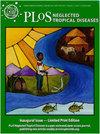厄尔尼诺-南方涛动和季节性天气条件对圣保罗州(巴西)埃及伊蚊侵扰的影响:贝叶斯时空研究
IF 3.4
2区 医学
Q1 Medicine
引用次数: 0
摘要
背景 天气的季节性波动被认为是影响埃及伊蚊及其携带的登革热等疾病的因素。厄尔尼诺-南方涛动(ENSO)被广泛认为是地球上影响最大的大气现象之一,其特点是海洋温度、贸易风强度和大气压力的相互影响,导致气候条件的广泛变化。在本研究中,我们探讨了厄尔尼诺/南方涛动和当地天气条件对埃及蚁侵扰指数时空变化的影响。方法 我们收集了 2008-2018 年期间亚热带圣保罗州(巴西)645 个城市的埃及姬蚊未成熟型(布雷图指数)的季节性昆虫学调查数据,以及气温、降雨和海洋尼诺指数(ONI)的数据。我们将分析方法建立在贝叶斯框架的基础上,并使用分层时空模型来研究由 ONI 跟踪的厄尔尼诺/南方涛动、季节性天气波动和幼虫指数之间的关系,同时对人口密度和贫富不均进行了调整。结果 我们的研究结果表明,厄尔尼诺现象对埃及蚁幼虫指数有相关的积极影响。特别是,我们发现,与中性(和弱)厄尔尼诺现象相比,厄尔尼诺现象(即温度≥1°C,中度至强度)的阳性容器数量预计将增加 1.30 个单位(95% 可信区间:1.23 至 1.37)。我们还发现,超过 153.12 毫米的季节性降雨量似乎对病媒指数有显著影响,可能导致室外废弃容器中积聚大量水分,支持蚊子的水生发展阶段。此外,23.30°C 以上的季节性温度与幼虫指数呈正相关。虽然圣保罗州作为一个整体具有有利于病媒扩散的特征,但也有一些特定地区更容易受到蚊虫侵扰,因为最易受影响的地区主要位于该州的中部和北部地区,而南部则是蚊虫大量繁殖的热点地区,尤其是在厄尔尼诺现象期间。我们的研究结果还表明,城市中存在的社会差异也是埃及姬蚊大量繁殖的原因之一。结论 考虑到由于气候变化的影响,预计未来几十年厄尔尼诺现象的频率和强度都将上升,因此迫切需要提高我们追踪和减少虫媒病毒爆发的能力。本文章由计算机程序翻译,如有差异,请以英文原文为准。
Effects of the El Niño-Southern Oscillation and seasonal weather conditions on Aedes aegypti infestation in the State of São Paulo (Brazil): A Bayesian spatio-temporal study
Background Seasonal fluctuations in weather are recognized as factors that affect both Aedes (Ae .) aegypti mosquitoes and the diseases they carry, such as dengue fever. The El Niño-Southern Oscillation (ENSO) is widely regarded as one of the most impactful atmospheric phenomena on Earth, characterized by the interplay of shifting ocean temperatures, trade wind intensity, and atmospheric pressure, resulting in extensive alterations in climate conditions. In this study, we investigate the influence of ENSO and local weather conditions on the spatio-temporal variability of Ae . aegypti infestation index. Methods We collected seasonal entomological survey data of immature forms of Ae . aegypti mosquitoes (Breteau index), as well as data on temperature, rainfall and the Oceanic Niño Index (ONI) for the period 2008–2018 over the 645 municipalities of the subtropical State of São Paulo (Brazil). We grounded our analytical approach on a Bayesian framework and we used a hierarchical spatio-temporal model to study the relationship between ENSO tracked by ONI, seasonal weather fluctuations and the larval index, while adjusting for population density and wealth inequalities. Results Our results showed a relevant positive effect for El Niño on the Ae . aegypti larval index. In particular, we found that the number of positive containers would be expected to increase by 1.30-unit (95% Credible Intervals (CI): 1.23 to 1.37) with El Niño events (i.e., ≥ 1°C, moderate to strong) respect to neutral (and weak) events. We also found that seasonal rainfall exceeding 153.12 mm appears to have a notable impact on vector index, leading potentially to the accumulation of ample water in outdoor discarded receptacles, supporting the aquatic phase of mosquito development. Additionally, seasonal temperature above 23.30°C was found positively associated to the larval index. Although the State of São Paulo as a whole has characteristics favourable to proliferation of the vector, there were specific areas with a greater tendency for mosquito infestation, since the most vulnerable areas are predominantly situated in the central and northern regions of the state, with hot spots of abundance in the south, especially during El Niño events. Our findings also indicate that social disparities present in the municipalities contributes to Ae . aegypti proliferation. Conclusions Considering the anticipated rise in both the frequency and intensity of El Niño events in the forthcoming decades as a consequence of climate change, the urgency to enhance our ability to track and diminish arbovirus outbreaks is crucial.
求助全文
通过发布文献求助,成功后即可免费获取论文全文。
去求助
来源期刊

PLoS Neglected Tropical Diseases
Medicine-Infectious Diseases
CiteScore
7.40
自引率
10.50%
发文量
723
审稿时长
2-3 weeks
期刊介绍:
PLOS Neglected Tropical Diseases publishes research devoted to the pathology, epidemiology, prevention, treatment and control of the neglected tropical diseases (NTDs), as well as relevant public policy.
The NTDs are defined as a group of poverty-promoting chronic infectious diseases, which primarily occur in rural areas and poor urban areas of low-income and middle-income countries. Their impact on child health and development, pregnancy, and worker productivity, as well as their stigmatizing features limit economic stability.
All aspects of these diseases are considered, including:
Pathogenesis
Clinical features
Pharmacology and treatment
Diagnosis
Epidemiology
Vector biology
Vaccinology and prevention
Demographic, ecological and social determinants
Public health and policy aspects (including cost-effectiveness analyses).
 求助内容:
求助内容: 应助结果提醒方式:
应助结果提醒方式:


